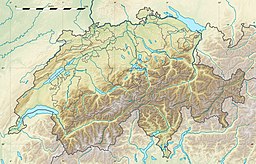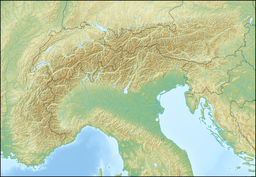
The Aare or Aar is a tributary of the High Rhine and the longest river that both rises and ends entirely within Switzerland.

Geneva is the second-most populous city in Switzerland and the most populous city of Romandy, the French-speaking part of Switzerland. Situated in the south west of the country, where the Rhône exits Lake Geneva, it is the capital of the Republic and Canton of Geneva.
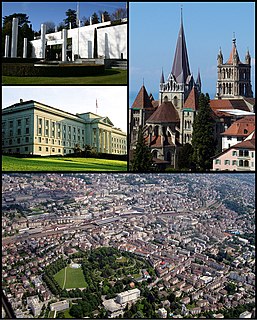
Lausanne (,, French: [lɔzan], German: [loˈzan]; is the capital and largest city of the Swiss canton of Vaud. It is a hilly city, situated on the shores of Lake Geneva, about halfway between the Jura Mountains and the Alps, and facing the French town of Évian-les-Bains across the lake. Lausanne is located 62 kilometres northeast of Geneva, its nearest larger neighbour.

The Rhône is a major river in France and Switzerland, arising in the Alps and flowing west and south through Lake Geneva and southeastern France before discharging into the Mediterranean Sea. At Arles, near its mouth, the river divides into the Great Rhône and the Little Rhône. The resulting delta forms the Camargue region.

Jura is a department in the Bourgogne-Franche-Comté region in Eastern France. Named after the Jura Mountains, its prefecture is Lons-le-Saunier. Its subprefectures are Dole and Saint-Claude. In 2016, Jura had a population of 260,517. Its INSEE code is 39. It has a short portion of the border of Switzerland.

Haute-Savoie is a department in the Auvergne-Rhône-Alpes region of Southeastern France, bordering both Switzerland and Italy. Its prefecture is Annecy. To the north is Lake Geneva; to the south and southeast are Mont Blanc and the Aravis mountain range.

Lake Geneva is a deep lake on the north side of the Alps, shared between Switzerland and France. It is one of the largest lakes in Western Europe and the largest on the course of the Rhône. Sixty per cent of the lake belongs to Switzerland and forty per cent to France.

The following is an alphabetical list of articles related to Switzerland.
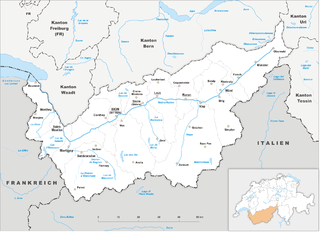
Valais, or Wallis, more formally the Canton of Valais, is one of the 26 cantons forming the Swiss Confederation. It is composed of thirteen districts and its capital and largest city is Sion. The flag of the canton is made of thirteen stars representing the districts, on a white-red background.
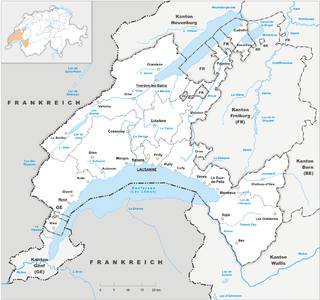
Vaud, more formally the canton of Vaud, is one of the 26 cantons forming the Swiss Confederation. It is composed of ten districts and its capital city is Lausanne. Its flag bears the motto "Liberté et patrie" on a white-green background.
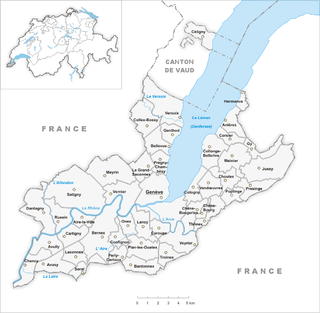
The Canton of Geneva, officially the Republic and Canton of Geneva, is one of the 26 cantons forming the Swiss Confederation. It is composed of forty-five municipalities and the seat of the government and parliament is in the City of Geneva.
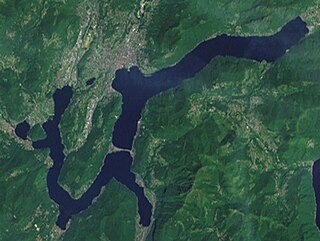
Lake Lugano is a glacial lake which is situated on the border between southern Switzerland and northern Italy. The lake, named after the city of Lugano, is situated between Lake Como and Lago Maggiore. It was cited for the first time by Gregory of Tours in 590 with the name Ceresio, a name which is said to have derived from the Latin word cerasus, meaning cherry, and refers to the abundance of cherry trees which at one time adorned the shores of the lake. The lake appears in documents in 804 under the name Laco Luanasco.

Lake Neuchâtel is a lake primarily in Romandy, in the French-speaking part of Switzerland. The lake lies mainly in the canton of Neuchâtel, but is also shared by the cantons of Vaud, Fribourg, and Bern. It comprises one of the lakes in the Three Lakes Region, along with lakes Biel/Bienne and Morat/Murten.
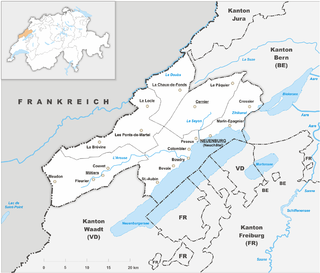
The Republic and Canton of Neuchâtel is a French-speaking canton in western Switzerland. In 2007, its population was 169,782, of whom 39,654 were foreigners. The capital is Neuchâtel.

Neuchâtel is the capital of the Swiss canton of Neuchâtel, situated on the shoreline of Lake Neuchâtel.
On 26 June 1964, Swiss Post introduced postal codes as the third country after Germany (1941) and the United States (1963).

Romandy is the French-speaking part of western Switzerland. In 2018, about 2.1 million people, or 25.1% of the Swiss population, lived in Romandy. The majority of the romand population lives in the western part of the country, especially the Arc Lémanique region along Lake Geneva, connecting Geneva, Vaud and the Lower Valais.

Lake of Gruyère is an artificial lake in the La Gruyère region of the Canton of Fribourg, Switzerland.

Prehistoric pile dwellings around the Alps are a series of prehistoric pile dwelling settlements in and around the Alps built from about 5000 to 500 BC on the edges of lakes, rivers or wetlands. In 2011, 111 sites located variously in Switzerland (56), Italy (19), Germany (18), France (11), Austria (5) and Slovenia (2) were added to the UNESCO World Heritage Site list. In Slovenia, these were the first World Heritage Sites to be listed for their cultural value.



